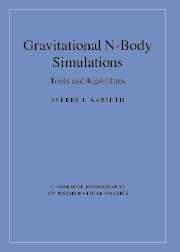Book contents
- Frontmatter
- Contents
- Preface
- 1 The N-body problem
- 2 Predictor–corrector methods
- 3 Neighbour treatments
- 4 Two-body regularization
- 5 Multiple regularization
- 6 Tree codes
- 7 Program organization
- 8 Initial setup
- 9 Decision-making
- 10 Neighbour schemes
- 11 Two-body algorithms
- 12 Chain procedures
- 13 Accuracy and performance
- 14 Practical aspects
- 15 Star clusters
- 16 Galaxies
- 17 Planetary systems
- 18 Small-N experiments
- Appendix A Global regularization algorithms
- Appendix B Chain algorithms
- Appendix C Higher-order systems
- Appendix D Practical algorithms
- Appendix E KS procedures with GRAPE
- Appendix F Alternative simulation method
- Appendix G Table of symbols
- Appendix H Hermite integration method
- References
- Index
6 - Tree codes
Published online by Cambridge University Press: 18 August 2009
- Frontmatter
- Contents
- Preface
- 1 The N-body problem
- 2 Predictor–corrector methods
- 3 Neighbour treatments
- 4 Two-body regularization
- 5 Multiple regularization
- 6 Tree codes
- 7 Program organization
- 8 Initial setup
- 9 Decision-making
- 10 Neighbour schemes
- 11 Two-body algorithms
- 12 Chain procedures
- 13 Accuracy and performance
- 14 Practical aspects
- 15 Star clusters
- 16 Galaxies
- 17 Planetary systems
- 18 Small-N experiments
- Appendix A Global regularization algorithms
- Appendix B Chain algorithms
- Appendix C Higher-order systems
- Appendix D Practical algorithms
- Appendix E KS procedures with GRAPE
- Appendix F Alternative simulation method
- Appendix G Table of symbols
- Appendix H Hermite integration method
- References
- Index
Summary
Introduction
Direct N-body simulations are of necessity expensive because of the need to evaluate all the N(N –1)/2 force interaction terms. We have seen that the Ahmad–Cohen [1973] neighbour scheme only alleviates the problem to some extent. However, once the particle number becomes sufficiently large, the dynamical behaviour begins to change because close encounters are less important. This behaviour has inspired methods for collisionless systems to be developed, such as tree codes or multipole expansions. In this chapter, we are concerned with tree codes since some relevant aspects of the latter have already been discussed. First we review the basic features of the pioneering Barnes & Hut [1986] scheme which is widely used in a variety of applications. Since the emphasis in this book is on collisional stellar dynamics, we devote a section to describing a tree code for point-mass interactions [McMillan & Aarseth, 1993] in the hope that it might be revived. The final section deals with an independent development for flattened systems [Richardson, 1993a,b] that has been used to study different stages of planetary formation as well as ring dynamics, where collisions play an important role.
Basic formulation
In view of the rapid growth in the computational requirements for increasing particle numbers when using direct summation, it is not surprising that several tree-based approaches have been made to speed up the expensive force calculation.
- Type
- Chapter
- Information
- Gravitational N-Body SimulationsTools and Algorithms, pp. 94 - 104Publisher: Cambridge University PressPrint publication year: 2003



